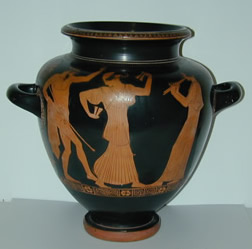GREEK VASES
Apart from their decidedly utilitarian use as storage vessels, Greek vases embody one of the most fascinating pictorial representations of Greek society through the ages. What we know about ancient Greek customs we find not only in literary texts, but displayed for our perusal on those most common of household utensils, utility pots for storage from olive oil, wine and water to funerary ashes. That most basic principle of Greek civilization, the interrelatedness between creative spirit and human endeavour, is embodied in every single pot.
In this small but representative collection of Greek vases, something is captured of the spirit of ancient Greece that has infused our civilization to such advantage. Let the pots therefore speak for themselves!
Click on picture for more examples

ROMAN GLASS
By the 2nd millennium BC glass already was produced to a high standard, especially in Egypt and Crete. It was mainly used as adornment. Faience articles were common in the Greek world, but after the technique of glass-blowing (1st century BC, probably in Syria) was developed, glass objects became generally available for utilitarian purposes - to the extent that glass replaced pottery in the Roman Empire.
Roman glass shows much variety in form and decoration. One of the most interesting uses of glass is in small teardrop glass bottles. Tears were collected in these bottles as a physical indication of feeling for the deceased and were buried with him/her. Cameos also developed as glass techniques improved, reaching a highpoint in the 1st century BC. Glass production flourished in the time of the emperor Augustus. Glass for windows was known by the 1st century AD (vide Pompeii, 79 AD). In the later Roman Empire glass was used as mirrors.Click on picture for more examples
